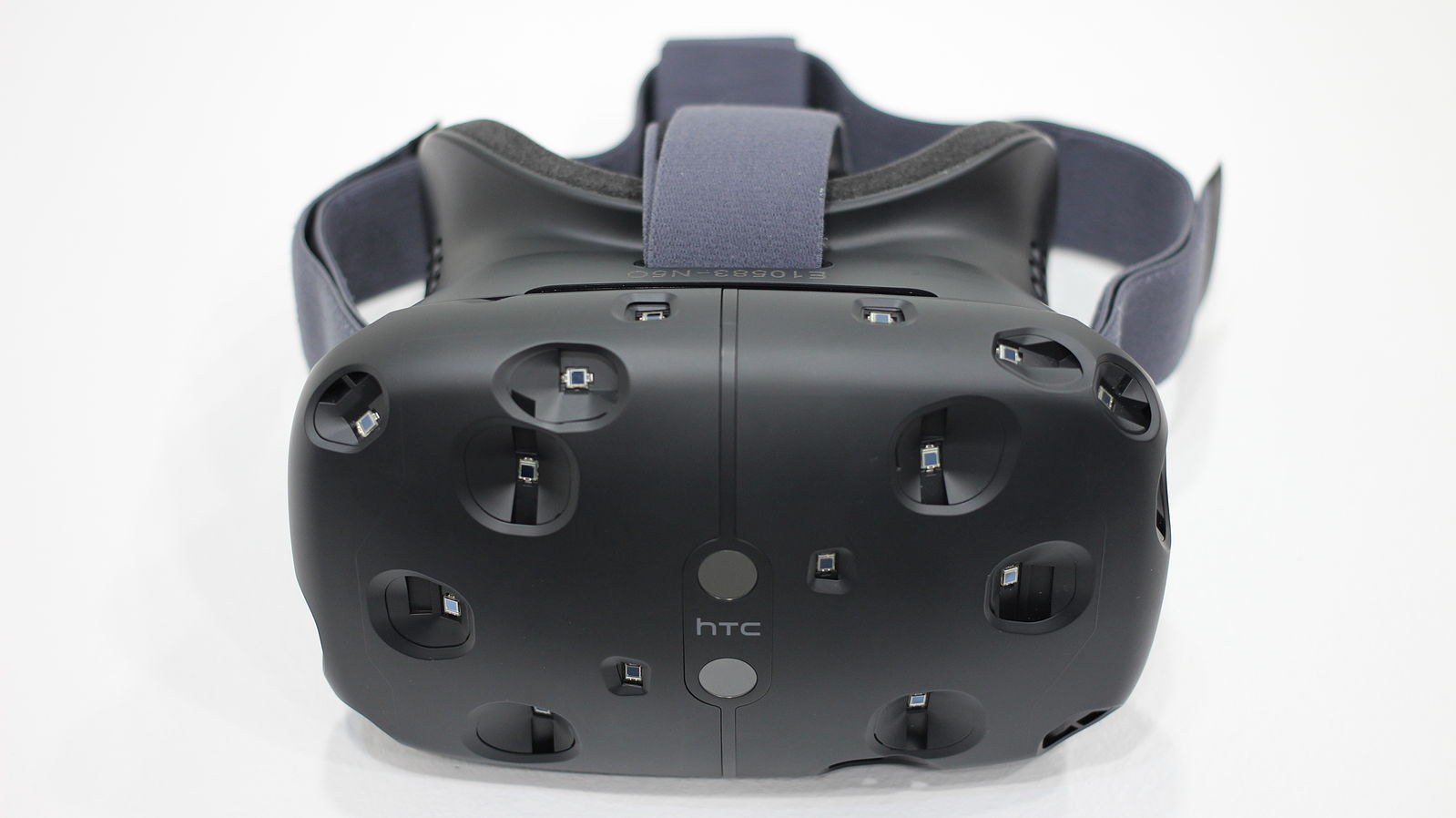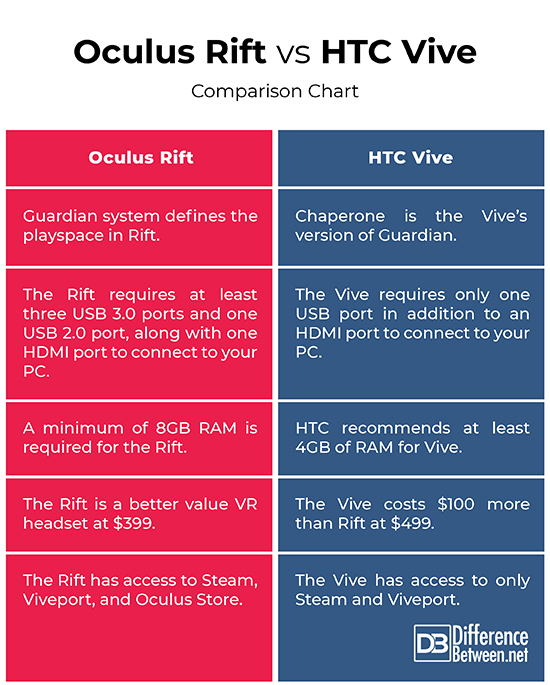Difference Between Oculus Rift and HTC Vive
When talking about technology of the future, what is the first thing that comes to mind? Some would say self-driving cars; well, some would like to have Jarvis in their homes too for sure. But how about a future where one could be able to create his own reality? Imagine sitting on the couch at the comfort of your own home and you put on a headset and suddenly, you’re walking on the streets of London thousand miles away. This is what virtual reality does; create imaginary worlds that would be virtually indistinguishable from the real world. What was once perceived as the technology of the future has become a serious consumer technology. That being said, Oculus Rift and HTC Vive currently sit at the top of the VR game and without a doubt, these VR headsets provide some of the most realistic experiences of any VR hardware till date.
What is Oculus Rift?
Created and manufactured by a division of Facebook Inc. known as Oculus VR, the Oculus Rift is one of the industry leaders is the virtual reality space – a VR headset capable of simulating reality generated by computer, giving you a feeling of being in a totally different world. This was the first generation of the Rift launched on Mar.28, 2016, which is now succeeded by the new and improved Oculus Rift S.
What is HTC Vive?
HTC Vive is one-of-its-kind virtual reality system developed by Taiwanese consumer electronics company, HTC Corporation in partnership with the American video game developer, Valve Corporation. It was released on April 5, 2016. It provides some of the finest and immersive virtual reality experiences with movements that make you feel like you’re in the action.
Difference between Oculus Rift and HTC Vive
Hardware in Oculus Rift vs. HTC Vive
Both the VR devices are fairly similar when it comes to hardware, considering both the headsets provide two screens with 1,080 x 1,200-pixel resolution per eye running at 90 Hz refresh rate and a 110-degree field of view. However, the Oculus Rift has a relatively smaller screen at 3.54 inches compared to HTC Vive’s 3.58-inch screen. HTC recommends at least 4GB of RAM for the Vive, while a minimum of 8GB is recommended for the Oculus Rift. Besides that, all the recommended system requirements to run either of the headsets remain the same.
Connectivity of Oculus Rift vs. HTC Vive
Probably, one of the main differences between the two VR headsets is connectivity. The Oculus Rift requires at least three USB 3.0 ports and one USB 2.0 port, along with one HDMI port to connect to your PC. The three Oculus Constellation Sensors need to be connected to the USB 3.0 ports and the headset requires one USB 3.0 port and one HDMI port on your PC’s graphics card. The HTC Vive, on the other hand, requires only one USB port in addition to an HDMI port to connect to your PC.
Sound
The Oculus Rift has built-in on-ear headphones found on both sides of the headset that can be adjusted based on the individual. The Audio Mirroring feature on the Rift allows audio to be played from both the headset and your personal computer at the same time simultaneously. The HTC Vive, on the other hand, comes equipped with a 3.5mm audio jack so that users can plug their own headphones into the port, if they do not wish to use the ones that’s included with the pack.
Controls in Oculus Rift vs. HTC Vive
While both Rift and Vive use wireless controllers, the original controller for the Oculus Rift is the Oculus Touch which is a half-moon-shaped device with buttons found beneath the thumb, fore and middle. The Oculus Touch controllers are very light and easy to use, providing an immersive VR experience. The HTC Vive’s button-covered Wands, on the other hand, comes bundled with the Vive and has all kinds of buttons on the outer ring of the controller, including the trigger and tracking sensors. The Rift’s motion controllers are more comfortable to hold though.
Games
Oculus Rift partnered with many game developers to produce new games that are compatible with a 3D environment, such as Esper , Chronos, Edge of Nowhere, The Climb, Bullet Train, and more. Viveport is the official app store for VR content and experiences for the HTC Vive, but isn’t centered around VR games. The Rift has the Oculus Store which redefines digital entertainment and maintains a marketplace for the apps. The Oculus Rift has the upper hand here, as it has access to both Oculus Store and SteamVR. Vive has no definite games made, but only demos are provided, which include Tilt Brush, Quar, Aperture Science, etc.
Price
The Oculus Rift was priced at $599 when it was originally launched by Oculus VR in 2016. The Rift recently slashed the price of its headset by $200, now selling at $399. The HTC Vive, on the other hand, costs $499, down from its original $799 price. The Rift is $100 cheaper than the Vive and has access to Steam, Viveport, and Oculus Store, so clearly Rift is the better value VR experience than the Vive, which only has access to Steam and Viveport.
Oculus Rift vs. HTC Vive: Comparison Chart
Summary of Oculus Rift vs. HTC Vive
Both HTC Vive and Oculus Rift are the first generation consumer VR headsets with a broad reach at this time and the largest consumer base. Without a doubt, they offer some of the most realistic and immersive virtual reality experiences of any VR hardware till date. Well, the competition is very close, when you pit the two VR headsets against each other, but it mainly comes down to personal preference. For most of us, the Oculus Rift may be the potential winner, mostly because it’s cheaper than the Vive and easier to setup too.
- Difference Between Caucus and Primary - June 18, 2024
- Difference Between PPO and POS - May 30, 2024
- Difference Between RFID and NFC - May 28, 2024
Search DifferenceBetween.net :
Leave a Response
References :
[0]Image credit: https://commons.wikimedia.org/wiki/File:HTC_Vive_(12).jpg
[1]Image credit: https://commons.wikimedia.org/wiki/File:Oculus-Rift-CV1-Headset-Front.jpg
[2]Mealy, Paul. Virtual & Augmented Reality For Dummies. Hoboken, New Jersey: John Wiley & Sons, 2018. Print
[3]Gutierrez, Mario, et al. Stepping into Virtual Reality. Berlin, Germany: Springer, 2008. Print



